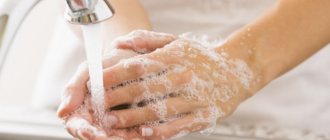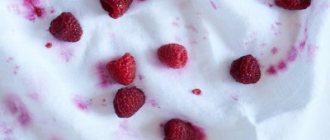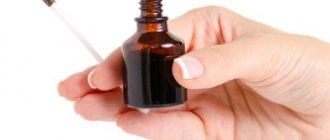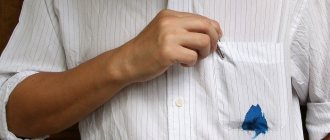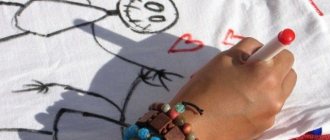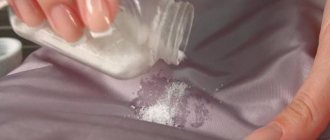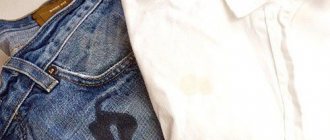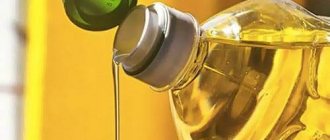For medical purposes, you have to use iodine, which is in every home medicine cabinet. During procedures, the substance often stains hands, clothes, bedding or interior items. Iodine stains are considered difficult to remove because the special composition of the medicinal product is quickly absorbed, penetrating deeply into the fibers, and dries. It is quite difficult to remove a dry or old stain, and dry cleaning often refuses this task.
However, a stain of iodine on clothing is not a death sentence. It can be easily dealt with at home. Chemical agents will also help to combat marks.
Recommendations for removing stains
The following tips will be helpful when removing iodine stains:
- When choosing a stain removal method, the type of fabric, degree and freshness of the stain are taken into account.
- The use of any cleaning substance must begin with testing. Apply a little product to an inconspicuous area of clothing or a piece of fabric and see the reaction.
- If iodine gets on synthetic and delicate fabrics, stain removers and chemicals should not be used so as not to destroy the fibers and spoil the item.
- Denim fabrics, products with the addition of synthetics and poor-quality dyeing, which fade even in warm water, are susceptible to exposure to chemicals.
- When using solvents and aggressive drugs, it is recommended to wear gloves to protect your hands from harmful effects.
- Immediately after iodine gets on the fabric, it should be washed off. When this is not possible, the blot needs to be blotted with a napkin, cotton pad or sponge. So, the substance will saturate the material less and is easier to wash off.
- The contamination is treated from the inside out, and an absorbent material, for example, cotton fabric, is placed on the front side.
- To avoid smearing the medical solution over the surface and spreading the stain, wipe it in a circular motion, moving from the edge to the center.
- The choice of product also depends on whose clothes are contaminated. It is preferable to clean the clothes of children, allergy sufferers and people with sensitive skin with home remedies.
- Chemical preparations cope better with traces of iodine and require less time and effort.
- A reliable assistant in the fight against fresh iodine stains is the sun. Under the sun's rays, recent pollution fades away. It is also recommended to dry things in the sun after removing iodine and washing.
What to do if iodine gets on your clothes
If there are drops of iodine on your clothes, you must immediately begin removing them:
- When choosing a method for removing traces, check the type of fiber, intensity and freshness of the stain.
- Before using household chemicals or folk remedies, check their effect on the material. To do this, apply a small amount of the composition to an inconspicuous area or piece of fabric, wait a few minutes and evaluate the reaction.
- If iodine ends up on clothes made from delicate or synthetic fibers, avoid using household chemicals and stain removers. Such compositions can completely destroy the material, making the item unsuitable for further wear.
- Please note that fabrics containing synthetics, as well as denim products, can fade when treated with chemicals and exposed to hot water.
- When choosing aggressive drugs and solvents, provide personal protective equipment and wear gloves. This will avoid the negative effects of toxic substances on the skin of your hands.
- When iodine appears on clothing, wash the contaminated area as quickly as possible. If this is not possible, blot the stain with a damp cloth, sponge or cotton pad. After such treatment, iodine will not be able to be absorbed into the structure of the material and it will be easier to remove it.
- Process marks not from the front side, but from the back. To do this, place a cotton cloth or other absorbent material under it.
- To eliminate the possibility of iodine spreading over the surface, treat the stain in a circular motion, working from the corners to the center.
Special chemicals provide faster results in removing traces of iodine.
The selection of methods and compositions for removing iodine also depends on the characteristics of the clothing owners. So, if you need to clean the things of children, allergy sufferers, or people with hypersensitivity to household chemicals, it is better to use safe and gentle folk remedies.
New marks can be easily removed in the simplest possible way. To do this, you need to hang contaminated clothes outside, and then wash and dry them.
Delicate materials
When caring for clothes made of silk, wool and other delicate materials, you should use exclusively oxygen stain removers with a gentle effect. Household chemicals, including acetone and alcohol-based solutions, contain aggressive components and can make the item unsuitable for use.
You can treat the problem area with starch or baking soda, without mixing the additives with vinegar, and then wash it with laundry soap.
The safest way to remove medical solution from delicate items is dry cleaning.
Natural fabrics
You can remove marks on things made from organic fibers with acetone. The liquid starts a chemical reaction with the pharmaceutical substance and neutralizes its components. But it is prohibited to use acetone on synthetic fabrics, as it can destroy their structure.
Iodine often gets on sheets and medical gowns made from natural fabrics.
If the material contains cotton fibers, it is better to use special bleaching compounds to remove yellow marks.
Chlorine-based stain removers, such as Belizna, work well with stains. To prepare the solution, you must take into account the manufacturer's recommendations from the label.
You can neutralize stains on natural fibers using raw potatoes:
- Peel and cut the tuber.
- Rub the released juice into the contaminated surface.
- Rinse the item.
Synthetics
Items made from synthetic fibers, especially polyester, should be treated with solutions with a low content of aggressive substances. The selected composition should be diluted with water and then applied to the area of clothing with traces of iodine. Ammonia, denatured alcohol and ammonia are suitable for processing.
It is better to avoid using active solvents and stain removers for synthetics. They are capable of leaving behind streaks and burning through fabric.
Leather and suede
An unpleasant mark on a leather skirt or suede bag can be wiped off with alcohol. If the mark is fresh and the iodine has not had time to be absorbed deeply into the fibers, you should treat the area with vodka, cologne or perfume. The listed methods do not provide such a quick result, but they eliminate fresh stains.
Starch is suitable for removing iodine from suede items.
This express remedy should be used according to the following instructions:
- Apply a thick layer of potato starch to fresh marks.
- After 15 minutes, brush off the component and repeat the procedure.
- After 30 minutes, wash clothes with laundry soap.
Knitten things
Glycerin is suitable for removing traces of iodine.
Instructions:
- Before processing, place the item in the washing machine and select a temperature setting of 60 ℃.
- After completing the procedure, rub the stain with a mixture based on water, chalk and glycerin.
- Cover the product with polyethylene and leave for 4–5 hours. During this time, the prepared mass will completely saturate the fibers of knitted clothing and dissolve the medicine.
- At the end of the procedure, rinse the item and dry it in the open air.
Shoes
You can use baking soda to remove iodine stains from shoes. Apply the powder to the moistened fragment and then cover it with a damp cloth. It may take about 8–10 hours for positive changes to appear.
A bleach-based product, such as “Belizna,” is no less effective. To remove stains, apply bleach to the contaminated area, and after 10 minutes, wipe off the residue with a brush or rough sponge.
Special means
Chemicals will help remove iodine from clothes, upholstered furniture, and rugs. The initial exposure of the tissue should be a minimum concentration of the substance. If there are no results after 2-3 attempts, the dosage can be increased.
Acetone
Acetone is not suitable for removing stains on colored or delicate fabrics. Active components cause discoloration of the area, and as a result the item will be damaged. To remove a blot, you will need to apply a small amount of acetone (nail polish remover) to a cotton pad or cloth napkin and lightly wipe the contaminated area. You can apply a napkin to the iodine print. A chemical reaction will occur and the stain will lighten. Repeat several times until completely cleansed. Wash the product with washing powder.
Hydrogen peroxide
To clean traces of iodine, soak the contaminated area on clothing in a solution prepared from 1 liter of water and a tablespoon of hydrogen peroxide.
Ammonia
Ammonia is suitable for removing stains on white clothes. You need to stir a spoonful of ammonia in a liter of cold water and treat the stain with this solution. Sometimes it's worth soaking. Leave for about 1.5-3 hours and rinse under cold water. To eliminate the characteristic odor, wash with conditioner.
A large and old stain is treated with ammonia without diluting with water. The procedure will take longer and must be repeated several times.
Photoreactive
A chemical reagent called sodium hyposulfite, which is used in a photo salon, will help remove iodine from clothes. Its effect on this type of fabric must first be tested on an inconspicuous area. Moisten the stain with the reagent, wait until it disappears and rinse under running cold water. Wash the item with plenty of powder and rinse thoroughly.
Vanish
Vanish successfully removes traces of iodine. It is used on wool, furniture and carpets because it works quickly and does not damage the fabric. After processing, the color retains its original brightness.
Stain removers
On the shelves with household chemicals you can choose a suitable stain remover or bleach for a given type of fabric. The basic application scheme looks like this:
- Prepare the solution in compliance with the proportions recommended by the manufacturer.
- Place the stained clothing or a separate area in it.
- Leave for a while and rinse in clean water.
Dish gel
Dishwashing gel is poured onto the stain and left for 3-4 hours. After this, moisten it with water, foam it and wait another 30 minutes. Finally, wash it in the usual way.
Using stain removers to remove iodine
Various preparations for removing traces of medical solution are available on the counters with household chemicals.
Their application consists of several stages:
- Preparation of the composition according to the manufacturer's instructions indicated on the label.
- Immersion of contaminated clothing or a separate fragment into the mixture.
- Rinse the item in clean water after soaking.
Vanish Gold
A fairly popular composition that copes with pollution of any degree of age and complexity. Applying the gel to the surface before immersing it in the machine will discolor the stain, and subsequent washing will completely remove the yellow-brown marks.
The algorithm for removing traces is quite simple:
- Distribute the gel over the contaminated piece of clothing.
- Rub the fabric with the bottom of the measuring cap.
- After an hour, remove the stain and place the item in the washing machine adding 100 ml of product.
In case of hand washing, the stain remover should be diluted in 4–6 liters of water, and then soak the item in the composition for 1 hour.
White products require aging for 5–6 hours.
Dr. Beckmann
The stain remover contains special substances that break down color pigments, but do not harm the shade and structure of the fibers.
To remove iodine from textiles you need:
- Soak the area with the product.
- After 10–30 minutes (depending on the degree of contamination), blot the stain with a napkin.
- Wash the product by hand or in a machine.
The product is suitable for dry cleaning and emergency removal of fresh marks. It also effectively copes with old marks.
Udalix Oxi
This is a universal product that is suitable for pre-treatment of stains, soaking and washing clothes in a machine.
To remove stains you need:
- Dilute 3 tbsp. l. drug in 2 liters of warm liquid.
- Immerse the textile item in the prepared solution for 30–45 minutes.
- Rub the yellow marks thoroughly with a clothes brush or your hands.
- Wash the item in the machine.
The highest effectiveness of the product is observed at a water temperature of 60 °C.
What to do with jeans
The peculiarity of cleaning jeans from traces of iodine is that they fade. For blue jeans there is an effective method based on a chemical reaction.
The area contaminated with iodine is moistened in cold water and a thick layer of potato starch is poured on top, which must then be slightly moistened. Leave for 12 hours for chemical reaction. As a result of the reaction, the iodine stain will become bluish in color. After the procedure, all that remains is to wash the jeans with laundry soap.
Cleaning the leather surface
Hydrogen peroxide removes traces of iodine from a leather jacket or sofa. Colored leather is soaped before treatment. This will protect against discoloration and spreading of the stain. Wipe the blot with a cotton pad soaked in hydrogen peroxide and rinse with cold water. if the procedure does not help, then treat with acetic acid. White and light skin is wiped with a disc soaked in boric acid.
Difficult cases of iodine removal
In some cases, traces of iodine on fabric cannot be washed off with folk remedies. To solve complex problems, you have to use professional household chemicals.
Jeans
Products made from high-quality denim are not afraid of almost any processing. New marks can be covered with soda, salt, starch or baby powder. Old stains will have to be scrubbed with ammonia, vinegar or acetone. It is better to avoid using chlorine-containing solvents. You should also not wash your jeans in boiling water.
Plastic
You can wipe off the medical solution from plastic with baking soda:
- Wet the stain with water.
- Sprinkle a layer of baking soda powder over it and cover it with a damp cloth.
- After 10 minutes, wipe the mixture off the surface.
When carrying out the procedure, it is important to take special care, since soda is enriched with abrasive particles that can harm the material.
Stains on the carpet and sofa
You can remove iodine stains on furniture or carpet with stain removers, a solution based on soda and vinegar, starch or ammonia.
You should dilute the potato starch with water until a paste appears, and then apply the mixture to the stain and leave for 15 minutes. Residues can be washed off with a sponge and cold water. To consolidate the results, the carpet must be vacuumed.
Parquet
The surface of the floor covering can be cleaned of iodine using lemon juice:
- Divide the fruit into 2 parts.
- Squeeze out a little liquid and apply it to a cotton swab.
- Wipe the problematic part of the parquet.
- Wait for the iodine to dissolve and rinse off the coating with clean water.
Cleaning the leather surface
To care for skin that has been stained with iodine, the following are suitable:
- Ammonia.
- Vodka.
- Acetone.
- Lemon juice.
It is forbidden to remove stains on the skin with ultraviolet light. When exposed to radiation, the material may dry out or become deformed.
Linoleum
To neutralize the medication on linoleum, you need to wipe the area with a damp cloth soaked in a mixture of citric acid and water. It is important to repeat the action until the marks completely disappear from the surface.
White fabric
If drops of iodine get on a white cloth, you can prepare ammonia:
- Dilute 1 tbsp. l. products in 200 ml of water.
- Soak a cotton swab in the solution and begin wiping away dirt.
- Wash clothes in a machine or by hand.
Palace
Baking soda should be applied to the problematic piece of carpet. After 12 hours, the layer must be removed by washing the carpet and drying it outside. Ethyl alcohol is suitable for removing difficult stains.
